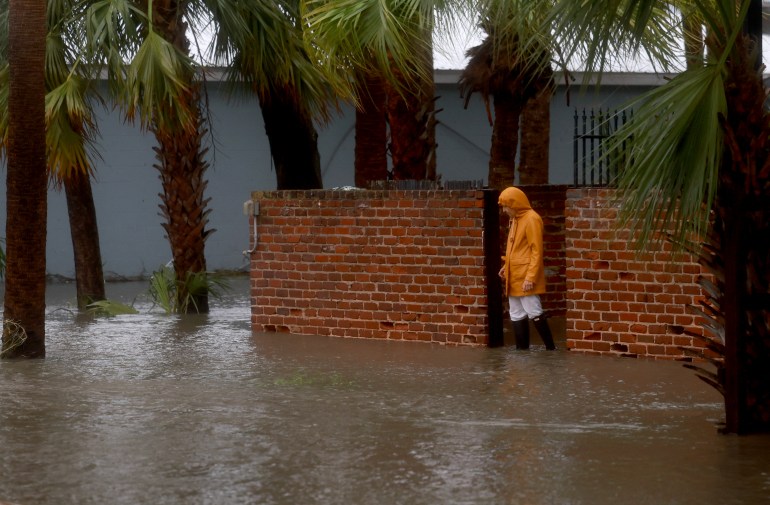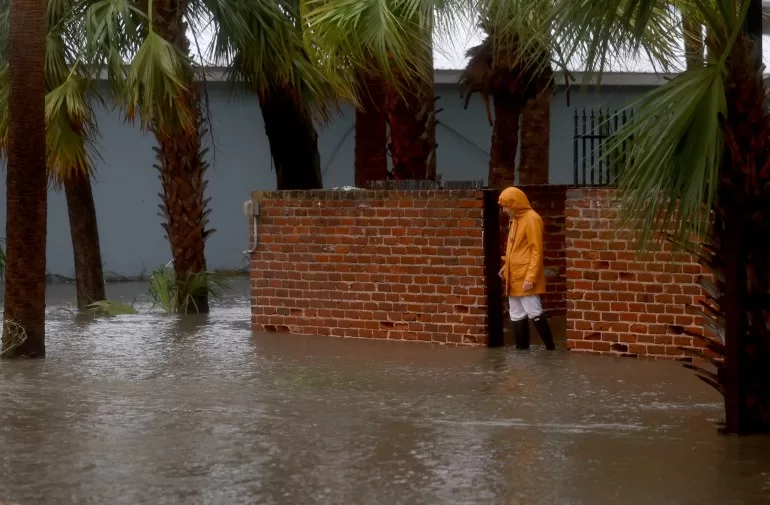Weather agencies warn the storm is expected to dump 6 to 12 inches of rain in Florida and 20 to 30 inches in coastal Georgia and South Carolina.
Hurricane Debby has made landfall as a Category 1 storm in the Big Bend region of Florida in the United States and has begun a slow crawl towards the Atlantic coast.
The hurricane slammed ashore on Monday in the region on the Gulf of Mexico about 7am (11:00 GMT) near Steinhatchee, Florida, about 115km (70 miles) southeast of Tallahassee, delivering winds of up to 130km/h (80mph), the National Hurricane Center (NHC) said.
“We have seen significant storm surge. We have seen inundation. We have seen and we’ll continue to see flooding in various parts of the state of Florida,” Governor Ron DeSantis told reporters, warning of a threat of “significant flooding events” in the coming days.
Debby had already dumped up to a foot (30cm) of rain in some parts of the state’s southwest, Florida Division of Emergency Management Executive Director Kevin Guthrie said.

The NHC warned that Debby is expected to dump 6 to 12 inches (15 to 30cm) of rain in parts of Florida and as much as 20 to 30 inches (51 to 76cm) in coastal Georgia and South Carolina before the week is over.
Mandatory evacuations have been ordered for part of Citrus County, Florida, with eight other counties under voluntary evacuation orders, local media reported.
The governors of Georgia and South Carolina have also declared states of emergency ahead of the storm’s arrival.
“This is going to be an event that is going to be probably here for the next five to seven days, maybe as long as 10 days, depending on how much rainfall we get,” Guthrie said.
Meanwhile, more than 300,000 customers have lost electricity so far, according to the tracker poweroutage.us. “We have a lot of restoration personnel ready to go to get it back on,” DeSantis said
Debby was a slow-moving tropical storm as it passed over Cuba, but it gained strength from exceptionally warm waters as it paralleled Florida’s coast on the Gulf of Mexico.
Debby bears some of the hallmarks of Hurricane Harvey, which hit Corpus Christi, Texas, in August 2017. Downgraded to a tropical storm as it moved inland, Harvey lingered over Texas, dumping about 50 inches (127cm) of rain on Houston and causing $125bn in damage.
Climate scientists believe man-made global warming from burning fossil fuels has raised the temperature of the oceans, making storms bigger and more devastating.
The last hurricane to make a direct hit on the Big Bend region was Hurricane Idalia, which briefly gained Category 4 strength before making landfall as a Category 3 storm in August 2023.
The National Centers for Environmental Information estimated it caused $3.5bn in damage. DeSantis described the initial effects of Debby as “modest” compared with Idalia.
Forecasters expect numerous Atlantic hurricanes in the 2024 season, which began on June 1, including four to seven major ones. That would exceed the record-breaking 2005 season, which spawned the devastating Katrina and Rita hurricanes.
